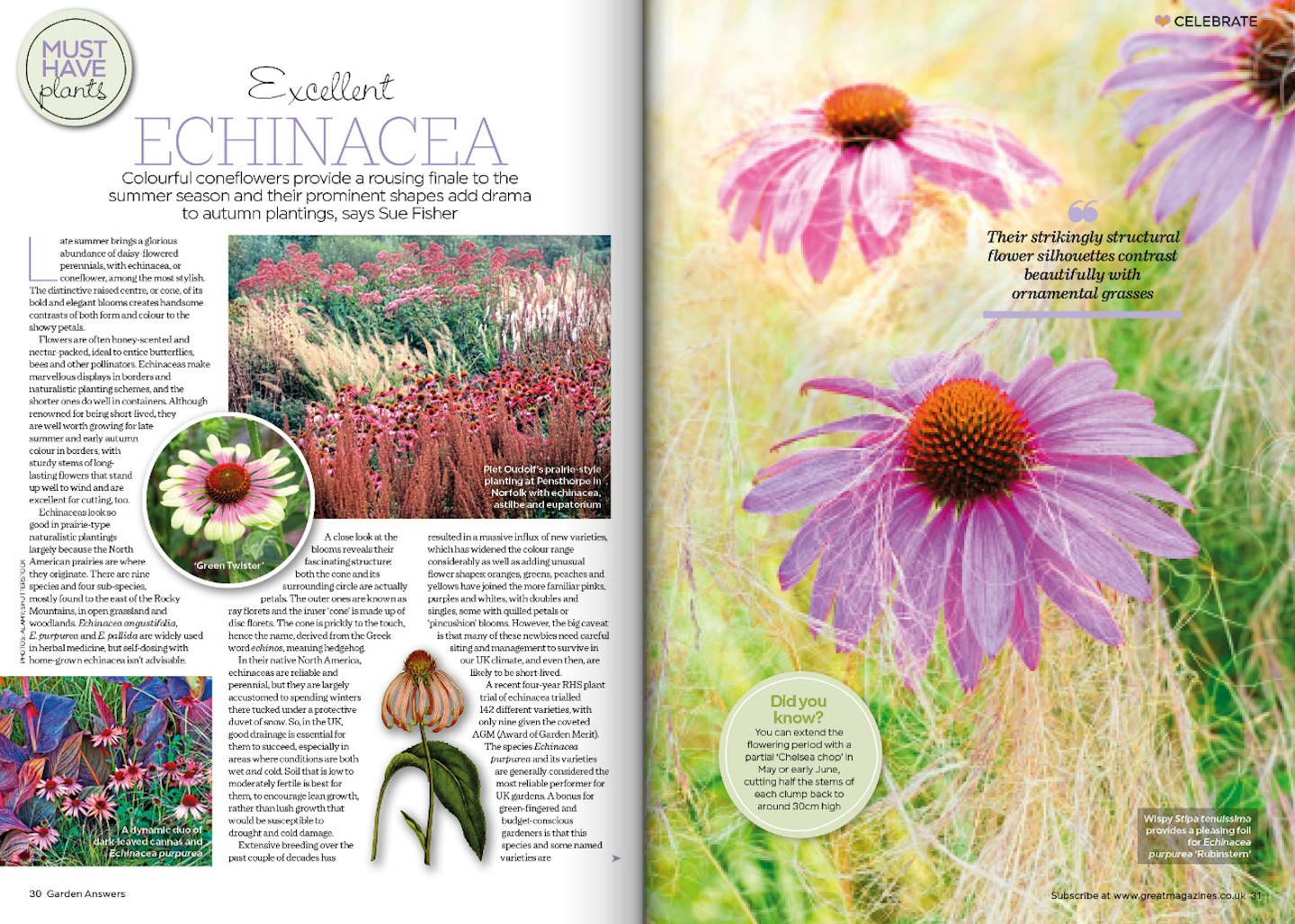
Colourful cone-flowers provide a rousing finale to the summer season and their prominent cones add drama to autumn plantings. Late summer brings a glorious abundance of daisy-flowered perennials, with echinacea or coneflower among the most stylish. The distinctive raised centre, or cone, of its bold and elegant blooms creates handsome contrasts of both form and colour to the showy petals.
Flowers are often honey-scented and nectar-packed, ideal to entice bees, butterflies, and other insects. Echinaceas make marvellous displays in borders and naturalistic planting schemes, and the shorter ones do well in containers. Although renowned for being short-lived, they are well worth growing for late summer and early autumn colour in borders, with sturdy stems of long-lasting flowers that stand up well to wind and weather and are excellent for cutting, too.
Echinaceas look so good in prairie-type naturalistic plantings largely because the North American prairies are where they originate. There are nine species and four sub-species, which are mostly found growing to the east of the Rocky Mountains, in open grassland and woodlands. Three species are widely used in herbal medicine: E. angustifolia, E. purpurea, and E. pallida, though self-dosing with home-grown echinacea isn’t advisable.
A close look at the blooms reveals their fascinating structure: both the cone and its surrounding circle are actually petals; the outer ones are known as ray florets and the inner ‘cone’ is made up of disc florets. The cone is prickly to the touch, hence the name, derived from the Greek word echinos, meaning hedgehog.
In their native North America, echinaceas are reliable and perennial, but there they are largely accustomed to spending winters there tucked under a protective duvet of snow. So, in the UK, good drainage is essential for them to succeed, especially in areas where conditions are both wet and cold. Soil that is low to moderately fertile is best, to encourage lean growth, rather than lush growth that would be susceptible to drought and cold damage.
Extensive breeding over the past couple of decades has resulted in a massive influx of new varieties which has widened the colour range considerably as well as adding unusual flower shapes: oranges, greens, peaches, and yellows have joined the more familiar pinks, purples, and whites, with double blooms as well as singles, some with ‘pincushion’ blooms or with quilled petals. However, the big caveat is that many of these newbies need careful siting and management to survive in our UK climate, and even then, are likely to be short-lived.
A recent four-year RHS plant trial of echinacea trialled 142 different varieties, with only nine given the coveted AGM (Award of Garden Merit). The species Echinacea purpurea and varieties are generally considered to be a safe bet and the most reliable performer for UK gardens. A bonus for green-fingered and budget-conscious gardeners is that this species and some named varieties are straightforward to raise from seed, often even blooming in their first year, making it possible to create glorious drifts of plants for just a few pounds.
Forming clumps of around 60-90 cm high and wide, echinacea blooms are borne on stiff vertical stems that rarely need staking, and which arise from basal clumps of lance shaped, hairy leaves. In the garden, echinaceas give the best show when planted in groups of drifts, happily rubbing shoulders with other perennials such as hardy salvias, rudbeckia, achillea, and coreopsis. Their strikingly structural flower silhouettes contrast beautifully with ornamental grasses, and especially the airy plumes of panicum or switch grasses; calamagrostis and miscanthus.
